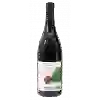
Saint Verny VignoblesLes Volcans Syrah
This wine generally goes well with beef, lamb or mature and hard cheese.
Food and wine pairings with Les Volcans Syrah
Pairings that work perfectly with Les Volcans Syrah
Original food and wine pairings with Les Volcans Syrah
The Les Volcans Syrah of Saint Verny Vignobles matches generally quite well with dishes of beef, lamb or spicy food such as recipes of flemish beer stew, leg of lamb brissac (leftover leg of lamb) or stuffed squid in the sétoise sauce.
Details and technical informations about Saint Verny Vignobles's Les Volcans Syrah.
Discover the grape variety: Biancu gentile
Biancu Gentile white is a grape variety that originated in France (Corsica). It produces a variety of grape specially used for the elaboration of wine. It is rare to find this grape to eat on our tables. This variety of grape is characterized by large bunches and large grapes. Biancu Gentile white can be found in several vineyards: South-West, Cognac, Bordeaux, Provence & Corsica, Rhone Valley, Loire Valley, Savoie & Bugey, Beaujolais.
Informations about the Saint Verny Vignobles
The Saint Verny Vignobles is one of of the world's great estates. It offers 88 wines for sale in the of Puy-de-Dome to come and discover on site or to buy online.
The wine region of Puy-de-Dome
The wine region of Puy-de-Dome is located in the region of Val de Loire of Vin de Pays of France. Wineries and vineyards like the Saint Verny Vignobles or the Saint Verny Vignobles produce mainly wines red, white and pink. The most planted grape varieties in the region of Puy-de-Dome are Gamay noir, Pinot noir and Chardonnay, they are then used in wines in blends or as a single variety. On the nose of Puy-de-Dome often reveals types of flavors of earth, citrus or sour cherry and sometimes also flavors of wild strawberries, pepper or leather.
The wine region of Val de Loire
Val de Loire is a regional PGI title, covering wines produced in an area that roughly corresponds to the Val de Loire wine region in northern France. The PGI catchment area covers 14 departments and is one of the largest in France in terms of area. The Terroir is extremely varied throughout the Loire Valley region. Wines produced under the PGI title have as much style as the AOC appellations of the Loire.
The word of the wine: Crunchy
A very colorful term to designate a sensation similar to the crunchiness of a grape bursting under the tooth in young and lively wines.













